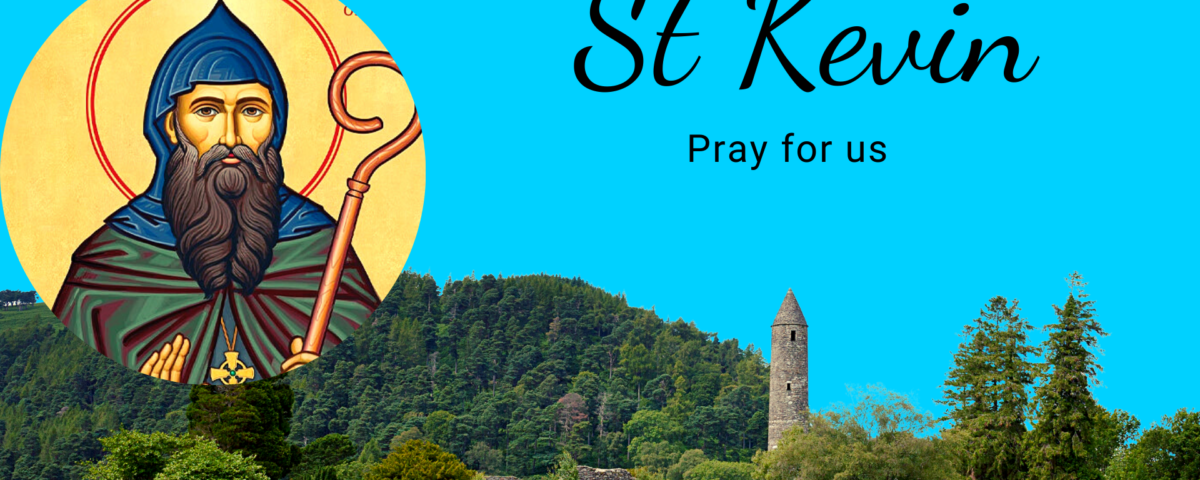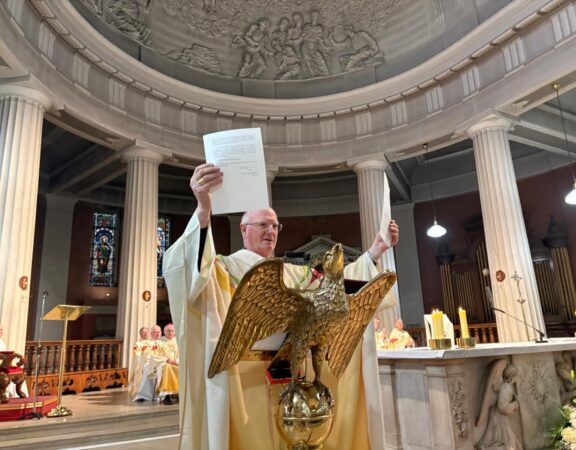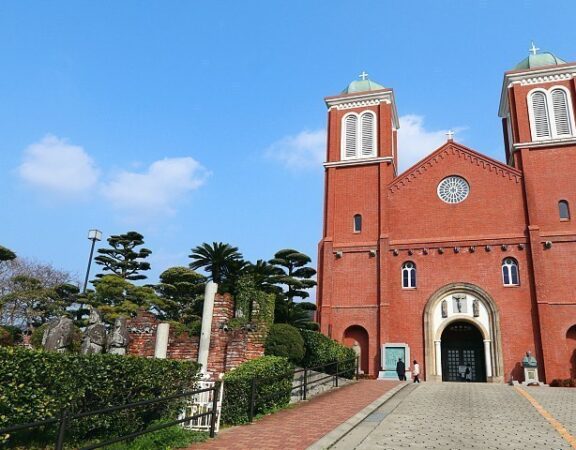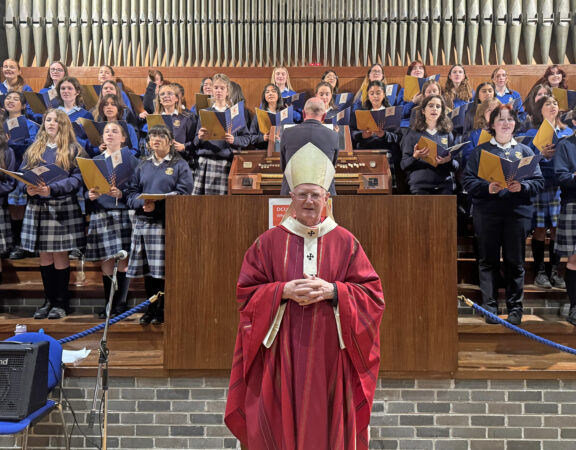Homily of Archbishop Dermot Farrell for the Feast of Saint Kevin,
Mass for the Metropolitan Chapter of Dublin,
3rd June 2021: St Mary’s Pro-Cathedral
I welcome members of the Metropolitan Chapter of Dublin to the annual Mass celebrated on the Feast of Saint Kevin who founded a monastery at Glendalough in the late 6th or early 7th century, a monastic settlement which reached its zenith in the 11th and 12th centuries, before eventually declining.
What is important is with that decline the Church did no die. The Church in Dublin today is a flowering of the Church of Saint Kevin. The Church centred around the monasteries of early medieval Ireland was replaced by the diocesan Church. When one studies the history of the Church in Ireland, there are five discernible historical phases:
- The Gaelic and Monastic Church
- The Anglo-Norman Church
- The Reformation and Penal Church
- The Post-Emancipation Church.
and now
- The Church in Contemporary Ireland
In each of these historical phases there was a beginning, a flourishing and a decline. In the words of Qoheleth: “there is a season for everything under heaven” (Eccles 3:1). God is the Lord of history. Christ was humble before history. We are foolish and vain if we think we are the lords of history. Such vanity—and its oftentimes dreadful consequences—belongs to the despots and tetrarchs of yesterday and today who dominate and oppress their people.
What remains constant in the midst of all the change?
Four things that are essential:
- The community without which there is no Church; our Christian faith is rooted in our humanity: the Word became flesh and dwells among us. This is at the heart of our faith.
- The living Tradition—made life-giving in the Spirit and actualized in the Scriptures. The risen Lord continues to speak to us through the Sacred Scriptures and in the words and witness of those who seek him with a pure heart (see Gaudium et Spes 1).
- The Breaking of Bread—the summit and source of the very life of the Church and of the faithful
- Prayer—the lifeblood of the Church’s life, where the Father’s closeness and care, and the fullness of His will are revealed.
Down through the centuries particular forms of Church life flourished, waned and were replaced by another one. The Church is continually changing and adapting. The people of God are a people on the move, a people on pilgrimage through life and history. This is how the Church actually is: never static, but continually responding to a changing cultural context. What we are experiencing today is a crisis in a particular historical form of Church. The Church, however, is more than any one particular historical form. Since change occurs over a period of years, our generation cannot easily see the contours—not to mention the final form—of what is going to emerge. However, just as the raindrops on the footpath suggests the imminence of rain, we are surrounded by signs of change that are as profound as they are imminent.
It is in this context that a change of emphasis in the Church is discernible in recent initiatives. For example, there is a deep and serious consultation to discern the promptings of God in our heritage and in the People of God. The Task Force, which I established under the title, “Building Hope”, is a step in that direction, as is the National Synod which was announced in March. What is now emerging is a different sense of “ownership” of the Church and its mission—from a “clergy-owned” to a Church truly “owned” by the People of God. This change, indeed, this transformation will take time. But there’s more: it also implies a different role and a new self-understanding by those of us in ministerial priesthood. We are servants of the Gospel of God (see Mark 1:14)—but we cannot continue failing to appreciate that all the baptised share this mission. We may no longer ignore that God’s people are the Church, and their contribution cannot be underestimated in the Church.
A Church that is re-discovering its mission is a Church where proclamation of the Good News moves to the centre. It is a Church which lives more to witness to the gospel than to manage or control the response of others to the demands of the gospel. This will mean a more diverse Church. A Church which is more diverse raises the question: who will be the people of faith in 10 years’ time? As we offer people living spaces of communion and of traveling together, the new face of the Church must be one where women and young people have a different visibility and where their voices are heard.
Among the raindrops falling on the Church’s path today are those that make it clear that the current parish system is not sustainable. The way we are Church in Dublin needs to evolve as the resources available no longer allow me to appoint priests, deacons and other pastoral ministers to meet the pastoral needs of every faith community. Moreover, the decreasing number of priests cannot limit themselves to an ever increasing number of sacramental celebrations. This situation requires decision and discernment to know what we bring with us from the past into the future.
There are certain things we do know:
God has not abandoned his people. The Good Shepherd has not run away from his flock. As it says, in the Gospel we have just heard: “if God so clothes the grass of the field, which is alive today and tomorrow is thrown into the oven, will he not much more clothe you—you of little faith?” (Matt 6:30). God has not abandoned his people. God has a new way and a new life for the Church in Europe, and that means for the Church in the Archdiocese of Dublin. Together as sisters and brothers in Christ, we are called to pray that He will show it to us, and that we will recognise it. We pray that the Holy Spirit will help us listen to the Lord and to realise that the Spirit also speaks through the voice of the lay faithful. “Every Christian and every community must discern the path that the Lord points out, but all of us are asked to obey his call to go forth from our own comfort zone in order to reach all the ‘peripheries’ in need of the light of the Gospel” (EG 20).
The current shortage of vocations to the priesthood and religious life could be discerned as God calling for change in the Church. Perhaps the Lord is indicating that it is time to make the necessary choices to build new models of ministry. To return again to the Gospel from today’s Liturgy: “seek first God’s kingdom of God and God’s justice…” (Matt 6:33) Renewal and change are first and foremost signs of life, the marks of a Church that advances on her pilgrim way, of a Church that in the words of today’s First Reading, “seeks out the Lord, seeks his strength, continually seeks out God’s presence” (1 Chron 16:11).
A renewed Church may be smaller, but as the then Joseph Ratzinger said: “From our present crisis the Church will emerge [from those who] … can put faith at the core of their experience. It will be a more spiritual Church, a Church of the poor, where people can glimpse something utterly new, a hope for their lives, an answer they have secretly hoped for.”
That was 1969—over 50 years ago! While nobody can foretell the future, there are people who have a sense of what is essential. Joseph Ratzinger—Pope Benedict, a true ‘father of the Council,’ was one of them.
All of this does not mean an easy path. If what we live together is [to be] genuine Christian community, then there will be failure and disappointment. However, in the words of the late Maria Boulding, “there must be room not only for the experience of failure but also for recognition that failure is the place where the paschal mystery happens. [The Church is not] some ideal community which has left the weakness behind.” It is not in such a Church that we shall come to know the living God. Renewal of the Church is not some flight into an imagined, idealized future. To cite Boulding again, “On the contrary: it is here and now, amid the frailty and inconsistency, where Christ’s Easter is experienced as power. In men and women as they are, sinful and redeemed, and allowing Christ’s compassion to flow freely among them: this is where the reality is. This is ‘experience of God.’ (Gateway to Resurrection, Burns and Oates, pp 18-19).
We do know that there has been an enormous change in Irish culture over the last number of years. This is having a significant impact on the role and understanding of the Church in Irish society. Responding effectively to this rapidly changing cultural diversity is a new challenge for the Church in Dublin. In the words of Pope Francis “the evils of the world—and those of the Church—must not be excuses for diminishing our commitment and our fervour. Let us look on them as challenges which can help us to grow. With the eyes of faith, we can see the light which the Holy Spirit always radiates in the midst of darkness, never forgetting that “where sin increased, grace has abounded all the more” (Rom 5:20). Our faith is challenged to discern how wine can come from water and how wheat can grow in the midst of weeds” (EG 84).
We are people of hope, and our hope is strong, because the Lord has promised to be with us until the end of time. It is in the spirit of hope that we should discern the best way to be the Church in Dublin in the years ahead. We do know that a radical renewal is required. We need to look to the future with creativity and imagination and in a way that enables the Archdiocese of Dublin to act now so as to give affective witness and service in the years ahead.
Being Church, being a community of faith is not a short-term project. Being Church is a long haul, a steady commitment that has to endure through the years, often unrewarding and baffling. Together we follow the path that the Lord shows us—as together we strive to grow in holiness and live this time of grace from the Lord. Together—this is a journey for the entire people of God in our diocese. Let us not forget that it was “the people who walked in darkness that saw the great light.” (Isa 9:2) It was the entire people who walked together in darkness. It was upon the entire people that the light shone. This is a community endeavour—slí le chéile. As I said on the day of my installation: “What we do in the coming months and years, how we live though this time of challenge and opportunity, will define who we really are as a people of faith. We must embrace the future: after all, today and tomorrow are God’s gift to us. Christ goes before his disciples: we follow. Rooted in our heritage, rooted in who we have become, Christ calls us forward (see Matt 4:19, Mark 1:38, John 21:15–18, Gal 1:15–16).”
Saint Kevin, in common with the early Gaelic monastics, knew how to pick a location for his monastery: he knew what he was doing when he chose Glendalough. Church is about people but is also about place: it is about seeking and discovering the place that gives and sustains life. Discerning a life-giving location for a community of hermits in early medieval Ireland is a different undertaking to discerning the spiritual centre for a community of faith in 21st century post-modern urban Ireland. But it can be done … the witness of the early Christians points to the finding of a way in a world that did not share their values or horizons.
Oremus invicem. Let us pray for each other. Let us speak with each other. And to take a line from Pope Francis, let us dream with each other. May the Lord open our hearts, and guide our feet on the way of renewal and peace. Let us “give thanks for the Lord for he is good, and his hesed, his faithful love endures forever” (1 Chron 16:34).
Saint Kevin, pray for us. Saint Laurence O’Toole, pray for us.
ENDS








